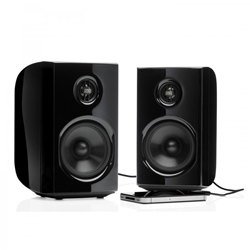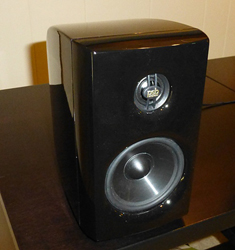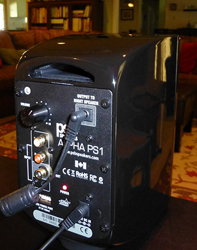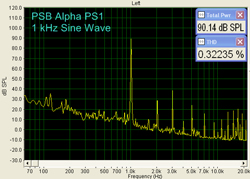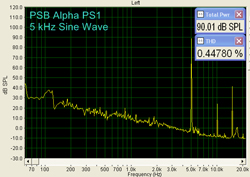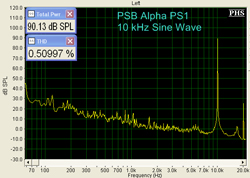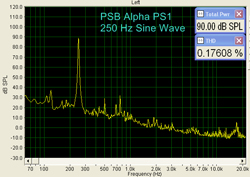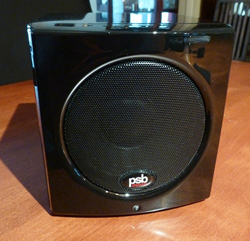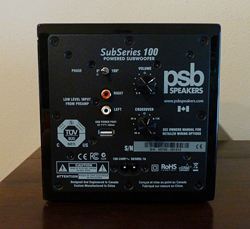Introduction to the PSB Alpha PS1 Speakers
The Alpha PS1s are PSB’s first powered speakers, and are bookshelf in size. Driven by built-in Class D amplifiers, they feature 3.5″ metalized polypropylene main drivers and 0.75″ aluminum dome tweeters in elegant ported enclosures. These speakers are the latest member of PSB’s Alpha line which has been very popular and well received by the audio press and consumers alike. (Late last year, PSB announced they would be releasing a super compact powered subwoofer. This new sub was designed to go along with PSB’s incredible little PSB Alpha PS1 ($299) desktop speakers that I reviewed in July 2013. So I promptly requested a review sample as I wanted to write this quick follow-up to my earlier review. This information is now on the last page of this review – See Update in ARTICLE INDEX on the upper right side of this page.)
PSB speakers celebrated their 40th Anniversary in 2012. This means they have a 40-year history of producing high quality loudspeakers of all kinds. PSB’s marketing byline is “Real Sound for Real People”. I personally find this to be apropos based on my first hand experience with PSB speakers: their speakers are high quality, affordable, accessible and have positive audible traits that everyday listeners can enjoy. The big question is, “Will the Alpha PS1s be able to sustain the family’s image?”
PSB ALPHA PS1 SPEAKERS SPECIFICATIONS
- Design: 2-way Powered, Ported (Woofer) Enclosure
- Drivers: One 0.75″ Aluminum Dome Tweeter, One 3.5″ Metalized Polypropylene Woofer
- MFR: 80 Hz – 22 kHz ± 3 dB
- Crossover: 2 kHz LR4
- Amplifiers: Two x 20 Watts
- Rear-Mounted Volume Control
- Inputs: One Set Stereo RCA, One Stereo 3.5mm
- 5V USB Power Port
- Subwoofer Output
- Weight: 4.2 Pounds/each
- Dimensions: 7.9″ H x 4.5″ W x 6.9″ D
- MSRP: $299/pair USD
- PSB
- SECRETS Tags: PSB, Speakers, Bookshelf Speakers, Audio
Design and Setup of the PSB Alpha PS1 Speakers
PSB’s marketing literature indicates that the PSB Alpha PS1s were designed to offer a more refined sound than typical computer speakers. Most small speakers accentuate the treble and/or the mid bass in an effort to sound “bigger” and to cloak their shortcomings. You can bet your bottom dollar that PSB wasn’t going to resort to similar trickery with their first set of powered mini monitors, particularly since the speakers would be the next advancement of the Alpha line, a line that has earned a great deal of credibility for excellent sound at affordable prices.
PSB goes on to say that they were able to hit their design objectives with the Alpha PS1s and the result is “a speaker with an extremely smooth and refined sound with surprising output capability and solid tuneful bass response that belies the Alpha PS1s diminutive size. The response off to the sides of the speaker has the same smooth response as the sound directly in front, making the Alpha PS1s acoustically ‘disappear’ by projecting a large and exquisitely detailed sound image. . . ” Is this a valid claim or just marketing hype? Let’s dig a little deeper and find out then.
To begin with, these are lovely little speakers. The small, deep ABS cabinets have a high gloss finish that simply looks “rich”. Grille-less, all you see are the metalized polypropylene woofers and aluminum dome tweeter. The tweeter’s waveguide is adorned with the PSB logo. The cabinets are rear ported which further promotes their clean, sleek appearance. The speakers have a satisfying heft.
The Alpha PS1 is a 2-way design sporting a 3-1/2″ metalized polypropylene main driver with an oversized magnet structure and a ¾” aluminum dome tweeter that handles frequencies over 2,100 Hz. The crossover slopes are fourth order.
Amplification for both channels is housed in the left speaker cabinet. The right speaker connection is by way of a supplied 6.5′ (2 m) speaker wire terminated with right angle mini plugs at each end. This wire is 20 gage and has ferrous chokes on either end. This connection proved to be adequate, while offering one potential upgrade path for the fussy audiophile.
The amplifier is an efficient Class D design that is rated at 20 watts per channel (wpc) continuous output. This rating doubles to 40 wpc dynamic peak. The speakers are not bi-amped and I don’t think this has any meaningful impact on the speakers’ performance one way or the other.
The PS1s have two analog inputs – a pair of gold-plated RCA’s and a 1/8″ (3.5 mm) mini plug. The speakers auto select the input with the mini plug taking precedence. A very nice touch is a mono subwoofer output. This sounded like an unfiltered output during the short time I tried it, so you will want to balance the sound using your sub’s internal low pass filter and volume control. Once set, the gain at the sub output will track the volume setting of the main speakers.
The rotary volume control is near the top of the back panel. There is a power indicator light on the back panel along with a USB plug that functions as a power port to charge a compatible USB device (no data).
The power supply is a universal, auto-sensing type that can be used in both North America and Europe.
I did the vast majority of my evaluation with theses speakers straddling the desk in my office. They were placed on either side of dual computer monitors and that put them about 4′ apart. This was pretty wide considering my ears were only about 30″ from the plane of the speakers. But the horizontal spacing was perfectly fine. The real problem was that the speakers were 20″ or so below my ears – this definitely affected the sound. So I later requested the optional tilt bases. The tilt bases replace the stock bases, raking back the speakers. The tilt bases proved to be a big improvement.
I later took the Alpha PS1s into my main listening room and set them up on the shelf where my Pioneer Kuro display resides. I did this so I could try the speakers with a high resolution source that was not available in the office. I replaced the tilt bases with the original bases. The speakers were 6′ apart and 6′ from my temporary listening position.
The PSB Alpha PS1 Speakers In Use
As mentioned in the previous section, the spacing of the PS1s was much wider than I would have gone for under normal circumstances, but the dual computer monitors on my desk obviated the possibility of closer spacing. This didn’t matter one bit as the horizontal dispersion and imaging proved to be amazing throughout the entire evaluation period. The center fill was likewise excellent. I’m not sure exactly how PSB was able to pull this off. The imaging mastery of the PS1s has to be one of the most uncanny things I have ever heard in all my years. And going beyond the imaging feats, I found that the PS1s had sweet highs, a tangible midrange and a satisfyingly rich sound through the upper bass/lower midrange.
Let’s get down to specifics a little bit. While in my office, the “source component” was my humble iPod Nano. All songs evaluated in this set up were ripped from Redbook CD’s in a lossless format and then down converted to 256 kbs MP3s when synched to my iPod.

I started with Kasey Chambers’ inaugural album “The Captain”. This record ignited the still quite successful career for this country singer-songwriter from Down Under. As I mentioned previously, the center fill on the PS1s was very strong. This was proven by the sound of Kasey’s voice floating transparently in space between the speakers about a foot above the cabinets.
The opening acoustic guitar on “Don’t Talk Back” had the tangible attack I’d become accustomed to with these speakers. This is a quality I equate to high current amplification and it leads me to believe the amps in the PS1s are conservatively rated. “The Hard Way” had tight and clean bass that subjectively extended to about 60 or 70 Hz. Meanwhile, all the instruments on this song had a natural timbre.

The next album I played was the Dirty Dozen Brass Band – “Funeral for a Friend”. This 2004 recording finds the band going back to their New Orleans roots with a series of songs that follow the progression from a dirge-like tempo on the way to the burial site to an upbeat return for the celebration. This is good stuff I recommend to any jazz fan.
The Dirty Dozen Brass Band is what I would call a medium-sized band. The PS1s demonstrated excellent specificity of instrument placement across a fundamentally diminutive stage due to the near field environment. But this was pinpoint placement with clear separation between instruments while keeping height cues intact. These speakers also passed a lot of information on this album that was presented with lots of air and space between successive notes.
I also loved the raspy brass instruments and grooving beats in the back half of the album. The PS1s had superb transient response on rim shots as well. I got carried away listening to this album!
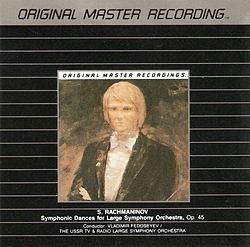
For my tastes, the PS1s are much better than a headphone experience – I can hear what is going on in the environment around me and the openness of the stage is well beyond the constraints of my skull. A good example of this is the MFSL CD of Symphonic Dances for Large Orchestra, Op. 45 as performed by the USSR TV & Radio Large Symphony Orchestra. This was indeed a large orchestra. Since the PS1s were arranged close by on my desktop, they were not physically able to paint as broad a canvas as you would hear at a live performance. But you would be surprised at the level of ambience retrieval PS1s offered. It was remarkable really.
I then moved the PSB Alpha PS1s into my large listening room. I used the stereo analog outputs from my Oppo BDP 83SE as the source component. Since this is a large room, the big dynamic swings were limited. You can also sense the speakers approaching their output limits when the layering of the sound begins to diminish. But when I kept the gain within the speakers’ capabilities, the sound from the PS1s was all around fuller and much louder than I have heard out of the 20 wpc integrated in my son’s bedroom.
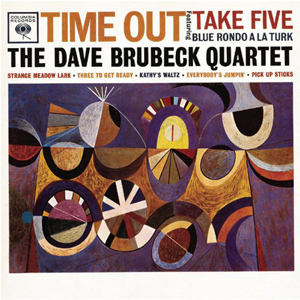
The first test was Dave Brubeck’s great classic “Time Out” on SACD. There was a slight electronic haze on the first track. This very slight haziness disappeared in later tracks, giving way to an addicting air and delicacy. The tweeters in the PS1s can hold their own against a vast majority of tweeters on the market these days.
The reproduction of Brubeck’s piano had a certain ease and comfort, the notes unfolding elegantly from these little gems. I was later drawn in by “Take 5” way more than I expected. There was decent weight and exceptional tonality on the upright bass as well. The layering and stage depth here were satisfactory, but the PS1’s sounded much more authentic on this point in the nearfield.

I closed out my subjective evaluation with a screening of the Wreck-It Ralph Blu-ray. I listened to the DTS HD Master track down converted to stereo and played over the L/R analog outs on the Oppo. The 8-bit sounds of the old video games in the opening credits were quite authentic. The sound again showed less depth in comparison to my reference speakers. The dynamics remained intact on this action-packed movie as long as I kept the volume within the design limits of the speakers. And the PS1s remained very musical speakers. This was clearly heard during the “Shut Up and Drive” scene. All in all, the PS1s laid down a surprising performance in the big room
Moving the Alpha PS1’s into the big room was a very successful experiment. I could see these speakers working well in a medium sized room. My enduring fantasy being that I will one day have a nice beach house. I’ll listen to the PS1s in the mornings while preparing elegant breakfasts that we will enjoy by the big picture window.
The PSB Alpha PS1 Speakers On the Bench
All the below measurements were taken in-room on the left speaker. I placed the speaker on the top plate of a heavy stand for the testing. The frequency response tests were performed at 1-meter while the distortion measurements were on-axis near field measurements with the microphone 1′ from the center of the driver under test.
The on-axis response of the PSB Alpha PS1s shows an exceptionally flat spectrum from 80 Hz to 18 kHz. There are room-induced fluctuations in the bass below 250 Hz.
At 30 degrees off-axis, the PS1’s had a response curve that was in many ways smoother than the on-axis test. The treble even extends better to 20 kHz. This quality is probably what promotes such great imaging as I discussed in my foregoing analysis. I don’t know how the engineers at PSB were able to pull this off. Finally, the bass showed a little more unevenness on this test.
The THD at 1 kHz and 90 db was 0.32%, with the first harmonic more than 60 db below the test signal!
At 5 kHz and 90 db, the THD measurement was 0.45%. The first harmonic is more than 65 dB below the fundamental! This is a very clean test plot.
Similar results were measured at 10 kHz and 90 dB.
At 250 Hz and 90 db, the distortion was amazingly low at just 0.18%. The first harmonic is also 60 dB down on this test plot.
The PS1’s did not extend much below 80 Hz, but the distortion measurement at this frequency and 90 dB was more than acceptable at 3.12%. This is excellent performance from a single 3-1/2″ woofer and 20 watt amplifier.
Conclusions about the PSB Alpha PS1 Speakers
The Alpha PS1s face some pretty stiff competition in the marketplace. They are competing head to head with a lot of other manufacturers’ offerings in the desktop speaker category. And it is a growing category with more and more product announcements each week. Some of the other speakers out there have specs and features that might lead you to believe they are “better” than the PS1s.
I say don’t be fooled by the hype. PSB’s Alpha PS1s have tuneful bass, tangible mids and a sweet, airy treble. They are conservatively rated: their performance goes beyond the power and bass extension ratings. They also have an uncanny imaging quality that lends itself to desktop listening in the nearfield. On the test bench, these little speakers measured very low levels of THD particularly when you consider their diminutive size.
All this equates to the PS1s’ musicality which is the most important achievement of all. That you can have all this for $299 is the proverbial icing on the cake. So these speakers get my highest recommendation. I just want to urge PSB to develop a new version that will accept digital signals thus eliminating one conversion in the reproduction chain. That would be even more awesome.
UPDATE about the PSB Alpha PS1 Speakers
Late last year, PSB announced they would be releasing a super compact powered subwoofer. This new sub was designed to go along with PSB’s incredible little PSB Alpha PS1 ($299.00) desktop speakers that I reviewed in July 2013. So I promptly requested a review sample as I wanted to write this quick follow-up to my earlier review.
PSB ALPHA PS1 SPECIFICATIONS
- Design: Powered Subwoofer; Sealed Enclosure
- Woofer: 5-1/4″ Polypropylene Cone with Elliptical Surround
- MFR: 39 Hz – 150 Hz
- Amplifier: Class D 50W RMS, 100W Peak
- High Gloss MDF Cabinet with ABS front fascia
- Rear mounted Volume Control, Variable Crossover and 0/180 Phase Switch
- Stereo RCA Inputs
- Weight: 6.05 Pounds
- Dimensions: 6.4″ H x 6.4″ W x 7.9″ D
- MSRP: $249 or $499 USD for the Complete Alpha 1-100 Package
- PSB Speakers
- SECRETS Tags: PSB, Speakers, Bookshelf Speakers, Audio
This tiny sub is dubbed the SubSeries 100 and sells for $249 on its own or as the Alpha 1-100, a complete 2.1 system comprising the Alpha PS1’s and the SubSeries 100 for $499, this represents a savings of $50 over purchasing them separately.
The SubSeries 100 is the smallest and most compact powered sub I have yet reviewed. It is a sealed unit with a 5-1/4″ main driver in high gloss MDF cabinet with ABS front fascia. It is powered by a 100 watt peak output Class D amplifier that is surprisingly full-featured with stereo RCA inputs, a variable crossover control, a level control, a phase inversion switch and a USB power port. There is no power switch: its default operation is via an auto-sensing feature. The cabinet is around a 6-1/2″ cube that weighs a very modest 6 pounds.
It comes with a power cord and a one-page instruction “manual”. This sheet basically shows the recommended settings when pairing the SubSeries 100 with the Alpha PS1’s. Not included is the mono interconnect cable you will need to connect the sub with your satellite speakers. I think PSB should throw in an interconnect with this product especially when you consider that most people would expect “plug and play” capabilities with this super compact system. (PSB does include the interconnect cable when purchased as the Alpha 1-100 system.)
I soon had everything hooked up and experimented at first with placing the sub on the floor under my desk. I didn’t like what I heard as the bass was disconnected from the whole. So I wound up placing the sub behind my left computer monitor and this turned out to be an ideal position for the SubSeries 100. Its small size affords excellent placement flexibility.
One major strong suit with the Alpha PS1’s would be their great sound staging ability. Adding the SubSeries 100 into the mix only served to further enhance this property. This is true with most quality subwoofers in my experience. The stage enhancement was evident on the John Mayer “Paradise Valley” CD where the added bass extension improved the ambience retrieval, widening the stage even further.
The apparent bass extension was down to around 40 Hz and I could feel the bass in my bones and chest a little bit on “I will be Found”. Bass extension and low distortion were plusses here but the bass from the SubSeries 100 tended to be a bit riper than my tastes.
For kick drum, I listened to the “Changed the Locks” track on the Lucinda Williams Live CD. This song opens with a brief drum solo that didn’t have nearly the slam and impact I am accustomed to on my big system but the pacing was exhilarating and the drums were satisfyingly deep considering this is a modest desktop system. The driving bass lines during this song are key to the musical experience and this little sub backed the track vastly better than the no-sub option.
All in all, the SubSeries 100 improved the entire musical presentation and took the experience to even higher levels of enjoyment. I did find the system’s limits when I was messing around with the Nine Inch Nails “Hesitation Marks” CD. But when dialed back to a responsible (and still pretty loud) level, the bass was taught and precise. I felt in my chest and bones again.
I wanted to try a movie with the system and so I pulled out my Blu-ray of “Riddick”. While the SubSeries 100 was not going to blow the doors off, it nevertheless acquitted itself handily and I had a jolly good time with this movie.
The SubSeries 100 is a substantial upgrade to the Alpha PS1 system. It offers clean, tight and precise bass down to about 40 Hz that expands the system’s soundstaging properties. Together, the whole is greater than the sum of the parts. So I would recommend getting this sub with your PS1’s if you have the cash to pay the little extra. Or you might try the satellites first and upgrade to the sub later. But why wait when you can start out with an optimal system at a discount from the start? I know one thing for sure. I have the best sound system of anybody in my office. That is for sure!



